
趣味淘宝的朋友圈并不大,但里面其实还是有挺多高手的,好在大家也不在乎笔者的无知,一直让笔者无知地显摆。由于最近笔者捡了许多瓷器,当然是大佬们不会看上一眼的那种。
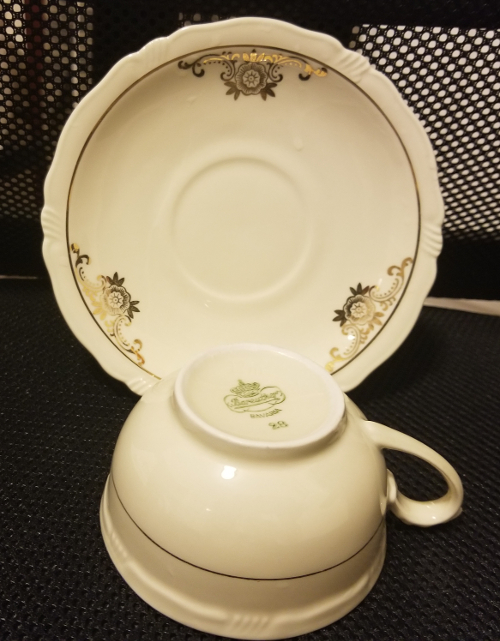
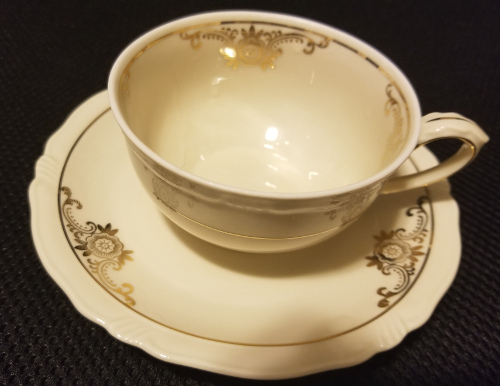
估计大佬们有些看不下去了,总算给笔者支招,关注德国瓷器,碰上好的,随便有几百年历史。对于笔者来说,除了中意英国的骨瓷茶杯外,中国瓷器一般不敢碰,水太深,可以说其他瓷器都没有注意,自然也包括德国瓷器。
听大佬们指点之后,笔者下决心关注一下德国瓷器。看来,老话说得好,“机遇偏爱有心人”。在一个周四,大部分并非趣味淘宝的日子,笔者刻意跑到临城的二手店。在去之前,笔者就让自己下决心,看看有没有德国瓷器。
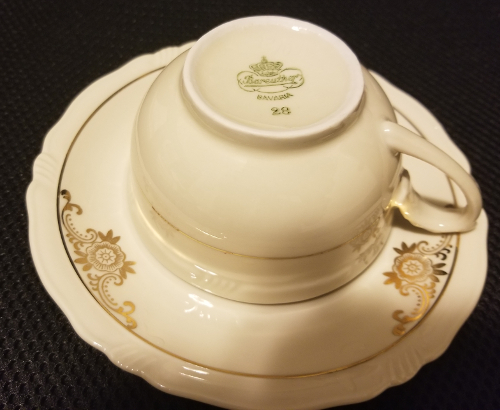
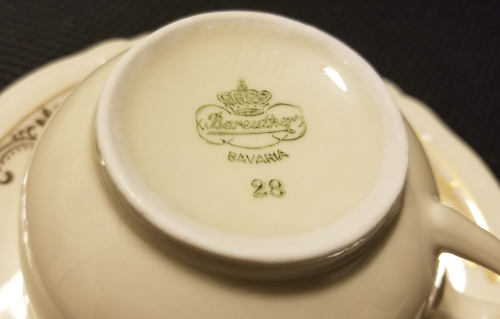
估计有些老移民可能知道,滑铁卢地区的Kitchener,原来的名字叫做“柏林”。二战之后,由于希特勒的臭名昭彰,加拿大人坐不住了,就改成了Kitchener。笔者看,“柏林”还真是一个不错的名字,其实不远就有一个小城,叫做巴黎。从地名来看,可见当年这里都是欧洲人的天下。
当年之所以叫柏林,自然是因为汇聚了一批德国人。不过这批德国人大多并不是直接从德国过来的,而是从美国过来的。考虑到这个背景,在这个区域关注德国瓷器,还是颇为有道理,对吧!这是题外话!
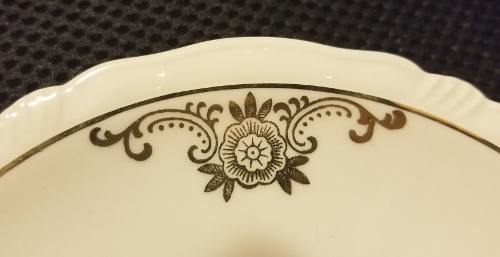
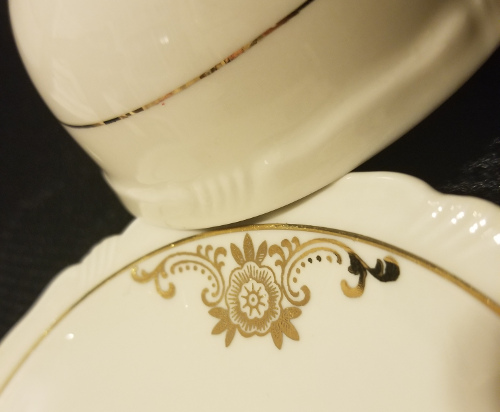
到了旧货店之后,笔者直奔瓷器部分,细心浏览起来。假若您熟悉二手店,估计您脑子里有印象,瓷器一般都会摆放几条高柜,然后分三层放置。在第二条开始的部分,最顶上一般都是放茶杯,笔者看了看几个英式茶杯,没有笔者中意的。而在高柜的另一边,摆着好几套茶杯,不是骨瓷,而是正常的瓷器。笔者小心拿下一套,一看底部落款,竟然是笔者心仪的德国瓷器。
仔细观赏之后,笔者还真让这套德国瓷器所吸引。看到标注有8套,笔者先将它们所有放在购物车,然后再看。这套德国瓷器之所以吸引笔者,可有多方面的原因,其一,初略一看,款式不是很常见;第二,尽管不是骨瓷,但如骨瓷哪般轻,敲打声音没有那么脆,但比一般瓷器沉闷的声音要好听多了;其三,在瓷器本身的做工上,凸显德国人的传统,在细节上特别精致;其四,瓶底或杯底落款有些特色,不仅有巴伐利亚州(Bavaria)的名字,而且还有皇冠的标徽,可见不是太差。
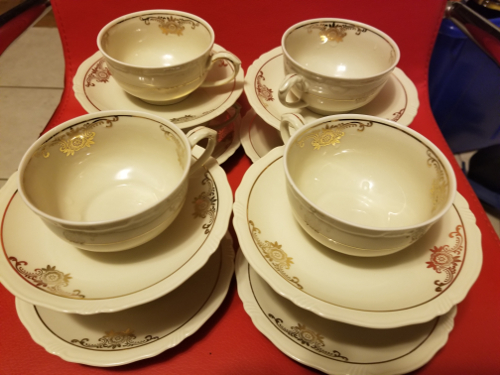
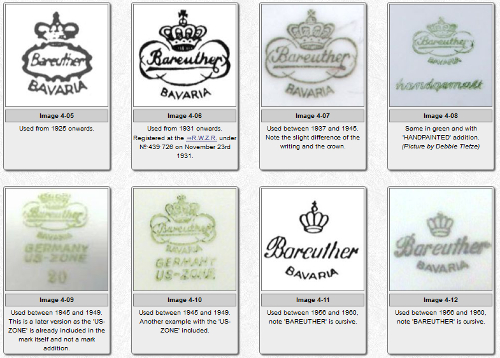
当天的淘宝自然就是购买了这8套德国茶杯,回来之后笔者自然会研究一番,才更好地了解这些茶杯。从落款上有Bareuther & Co,由此成功追溯到制造厂家的历史,并幸运地找到标徽与年头的对应表格。假若您细读下面的文字,您就能够全面的了解这些瓷器的来历的!当然,假若您有问题,也尽可能给我们留言哦!
Steingutfabrik Johann Mathäus Riess (1866 until 1885)
In 1866 the former chief potter of the C.M. Hutschenreuther factory in Hohenberg, Johann Mathäus Riess (born in Ottenlohe near Hohenberg) founded his own pottery in Waldsassen but died only a year later. The impressingly successful business was taken over by his son Johann Riess, who in 1875 also started producing porcelain. Over the next years, young Riess ran into more and more problems which finally forced him to sell the facility to Wilhelm Schreider from the town of Schwarzenhammer in 1884 as the facility employing 100 people at the time was nearly bankrupt. Schreider himself then sold the facility a year later.
Porzellanfabrik Jena, Bareuther & Co. (1885 until 1887)
The industrials Max Jena (Selb, Bavaria), Ernst Ploß (Asch, Bohemia) and Oskar Bareuther (Haslau, Bohemia) took over and after modernizations started to slowly but surely increase quality and output. Max Jena left the company in 1887, resulting in a rename of the company.
Porzellanfabrik Bareuther & Co. (1887 until 1904)
Bareuther and Ploß constantly improved the facility and the success they were having slowly let the workforce increase to 150 people in 1890. Further improvements and expansions followed, leading to a total of seven normal round kilns and one dedicated decoration kiln, followed by an even larger workforce as more and more skilled workers joined the company. In some areas like decoration styles, the company started to cooperate with others like the ⇒Porzellanfabrik Königszelt A.G. in Silesia, which resulted in a constant technology transfer between both companies – the best known would be the ‘Indisch Blau’ decoration style.
Based on the high quality standards, company reputation literally exploded. To cope with the demand, even further investments were needed to optimize the production process and these were made possible after the businessman R. Schmerler from Eger joined the company in 1902. One of the technical additions was the installation of a 130hp steam engine ordered at the Maschinenfabrik Heinrich Rockstroh from the town of Marktredwitz which was delivered and installed late in 1902. In the year 1904, the official workforce count showed an impressive number of 600 employees and on September 29th 1904 the company was transformed into a corporation.
Porzellanfabrik Bareuther & Co. A.G. (1904 until 1969)
The next years were relatively eventless and the workforce count for 1913, like 1906, showed a number of 600 employees. By 1930 the number had increased to 700, only to drop back down to 650 in 1937. The company itself – with an impressive number of twelve large kilns – was one of the top players in the porcelain industry, setting standards in quality assurance and investment strategies, a point that should pay off later as it helped the company recover after the war.
During the second world war, the facility was nearly completely destroyed and the former impressive workforce was shattered. Even if the facility was a ruin, its board of directors was completely functional and after the war one of the first steps was to contact the former workers of the Porzellanfabrik Königszelt ⇒A.G., who were practically homeless as the former Silesia had been declared Polish territory and all remaining Germans were forced to leave.
Needless to say, it only took a short time for the word to spread and most workers found a new job at ‘Bareuther & Co.’ – it was time to restart. With enormous financial effort completely covered by company funds, the combined workforce started providing housing possibilities for the refugees and then started to rebuild the facility – it was one of the first large facilities to be fully operational in 1949 and already having a workforce of 417 people. It should be noted here that in commemoration of the long-time cooperation and the events after the war, the company created the factory mark ‘Königszelt Bayern’ (Königszelt Bavaria) in the year 1979.
First items had been produced again from 1947 onwards, but these were only cheap and basic products to cover the demand in shattered Germany. As one of the first regulars back in the market, the company slowly increased its product range and soon one the largest manufacturers in Germany again, especially during 1955 and 1965. Constantly expanding, the company merged with the ⇒Gareis, Kühnl & Cie. on July 1st 1969. This merger resulted in a total workforce of a thousand employees and a name change, proudly hinting that it was now the only company in Waldsassen.
Porzellanfabrik Waldsassen Bareuther & Co. A.G. (1969 until 1994)
After the merger, the company increased their position on the market, soon to be rewarded by reaching rank number six of all German porcelain manufacturers. But its proud years slowly passed and especially from 1990 onwards the competition from low-wage countries started to take its toll and finally led to more and more dismissals. The company had to file for bankruptcy in 1994 and was erased from the trade register 1996. After the closure various attempts to sell the facility failed mainly because of the enormous amount of money needed for decontamination of the polluted soil, a result of the many chemicals used in porcelain production. In the year 2002 the state of Bavaria itself had to stand up for the process as the contaminated areas were endangering the ground water supply; demolition of the abandoned factory started in 2006, making room for a shopping center.










